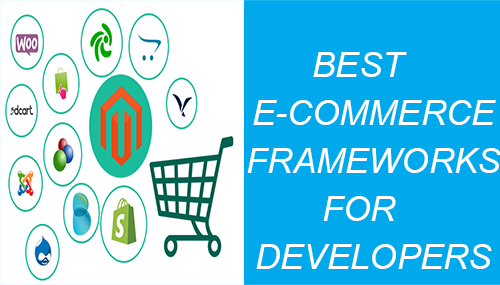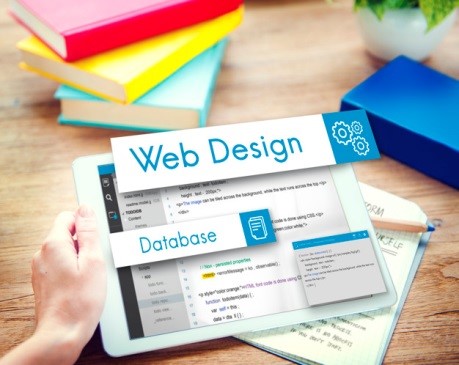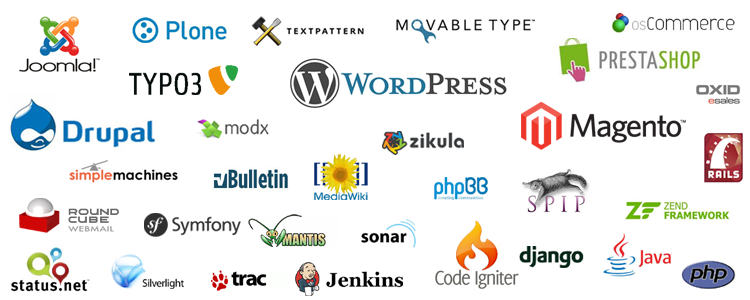Best E-Commerce Frameworks Developers Should Learn
With technological advancements, more and more online stores are coming into existence. Thus, learning and mastering e-commerce-based web application development is getting popular among developers with each passing day. This article discusses what are best e-commerce frameworks for developers.
Electronic commerce or E-commerce terms refer to the buying and selling of the services and goods as well as the transmitting of data or funds over the electronic system that is the internet. E-commerce is often used interchangeably with e-business.
E-commerce is a broad term that encompasses internet banking, online auctions, online ticketing, and payment gateways. There are basically four types of e-commerce:
- Business to business
- Business to consumer
- Consumer to consumer
- Consumer to business

Companies today prefer to hire developers with knowledge and experience in e-commerce web development. Thus, to grab the present and future opportunities, learning e-commerce frameworks for developers is a must to develop high-quality business websites and applications.
There are a variety of e-commerce frameworks for web developers with efficient functionality and high-usability. Before we explore those frameworks, let’s first get to know why e-commerce is the business model of the present and future.
How Businesses Benefit From E-Commerce?
Here are the following advantages e-commerce offers to businesses:
More Convenient: E-commerce can occur seven days a week and 24 hours a day.
Better Marketing Opportunities: One of the best marketing tools a business has is its website. Using SEO on websites can lead to higher chances for a business to be on top of search engines. Other marketing techniques can also link back websites like email marketing, social media marketing, and pay per click.
Huge Selection: Various stores online have a wide selection of products as compared to their physical outlets. Many stores that exist online have more consumer exclusive inventory that is mostly not available elsewhere.
Targeted Communication: An e-commerce trader can get access to a lot of information about customers that they provide in the registration form or by placing cookies on the customer’s computer. It helps to communicate relevant messages to potential customers.
Scalable: With the growth of the business, merchants want to grow their product range as per the consumer demand and customer requirements to increase the target audience. Anyone can scale a business accordingly with an e-commerce website without worrying about moving to larger sites or changing locations.
So, now you know how vital e-commerce is for all types of businesses and professional fields and why learning e-commerce web and app development is a must for developers. Now, this learning requires mastering E-Commerce frameworks.
Thus, here we present the best e-commerce frameworks developers should learn.

What Are Some Good E-Commerce Frameworks?
What is an e commerce framework? An E-commerce framework is a software used to develop e-commerce stores or sites. These frameworks provide all the requirements regarding the development in every category of e-commerce web application or online shop.
With the increased demand for online stores, the demand for e-commerce framework developers has also increased. Here we have briefly discussed top e-commerce frameworks in different domains.
Popular Frameworks for PHP Developers
Magneto:
This e-commerce platform is built on a free open source technology, whereas; Magneto Commerce Cloud is a paid custom solution. It is a very robust system and a flexible modular architecture. It offers a flexible shopping cart option and control over the functionality, content, and look of the online store to the merchants.
The database of Magneto requires strong servers and is resource-heavy. It also offers powerful search engine optimization, catalogue management, and marketing tools. Normally Magneto developers specialize either in front-end or back-end.
Some of its benefits include:
- Easy installation and additional plug-ins and layouts
- A cost-sensitive and effective program
- Provides over 50 gateways of payments
- Allows various promotions and discounts during checkouts
- The open-source technology offers scalable and flexible e-commerce solutions.
OpenCart:
It is a free open source e-commerce framework for online sellers. It provides a reliable and professional foundation to build a successful store online. The framework offers a wide range of features that give merchants a stronghold to customize their store.
Here are some benefits of choosing the OpenCart framework:
- It is easy to develop and use
- It offers community support and rich documentation.
- Changes can be made easily to the OpenCart store.
- It has thousands of modules and extensions.
- It has two virtual file structures OCMOD and VQMOD.
- It is SEO-friendly and has ready-to-use templates.
- It has a multi-store mode and offers multilingual support.

WooCommerce:
It is a free plug-in and simple e-commerce framework. The free ecommerce platform is the finest way to transform a WordPress website into a fully functional free ecommerce website and store.
Below are some of the advantages of the WooCommerce plug-in:
- Just like WordPress, it’s a free, open-source framework.
- It is the most popular e-commerce plug-in for WordPress
- One can set up and configure it by self. Its setup is fast and can be configured in a matter of an hour.
- There is no need to ditch the design of the current website. WooCommerce works with any theme or layout of the existing WordPress site.
Joomla:
It is a PHP-based award-winning content management system platform, with about six percent of the market share. It is mostly used by individual e-commerce owners of stores, schools, and colleges. Joomla is also a free and open-source platform.
It has a thriving community of designers, developers, and hosts with 700,000 e-commerce websites and stores.
Developers with less experience in programming languages can successfully enable Joomla. The extensions and plug-in development offered by the Joomla are adequate to operate any website optimally.
Bagisto:
It is powered by the Laravel framework of PHP and is an open-source e-commerce framework. It offers an extensive range of e-commerce enabled features that make it a go-to platform for entrepreneurs and start-ups.
- Developers can make a multi-vendor marketplace with powerful SEO and RTL features.
- From a single website, you can control multi-channel inventories and link the store with various inventory sources.
- With Bagisto, it is easy to monitor the product stock in the given inventory.
Popular Frameworks For .Net Developers
NopCommerce:
It is an ASP.Net Core-based free and open source website builder launched in 2008. It is a highly secure, scalable, and robust system with highly sophisticated e-commerce sites, add-ons, themes to develop. On NopCommerce, it is easy to maintain, extend, and upgrade all the websites and extensions.
Its architecture is extendable, which means developers can customize and extend the system without interfering with the platform’s core architecture.
Its features include:
- Multi-vendor and multi-store
- Responsive design
- CMS and SEO features
- RTL Support
- Tax configuration with EU VAT
- GDPR compliance
- Multiple payment and shipping methods
- Multilingual and multi-currency support
Vitro Commerce:
It is ASP.NET based open-source e-commerce platform. Vitro Commerce was launched in 2013 and is suitable for small to large businesses and B2B and B2C e-commerce companies. It is built on top of the .NET 4.6
The architecture of Vitro Commerce can also be extended with add-ons and modules. It has RESTful API and uses Liquid for markup the front-end. It offers front-end authentication solutions and back-end ERP system integration.
Other features include:
- PIM (Physical Information Management)
- Multi-tenant and multi-store
- Content Management System
- Responsive Pricing Engine
- A distributed order Management platform
- Product recommendations with machine learning
Popular Frameworks For Java Developers
Hybris:
It is a popular Java-based e-commerce platform for B2B businesses and Omni-channel companies. Hybris offers marketing tools and commerce solutions. Omni-channel commerce solution is aimed to improve communication with customers by providing a consistent and meaningful experience across the available channels.
- For marketing solutions, Hybris is a highly scalable and agile tool that offers superior customer insight.
- It helps the clients to reach their customers everywhere and every time. Hence, they can boost loyalty easily by delivering the finest customer experience on a real-time data basis.
- The Vitro Commerce framework offers five themes and 43 extensions, including customer and content management modules, payment gateways, integrations, inventory, and more.
Hippo:
This open-source e-commerce solution emphasizes on multi-channel experience and real-time data. Hippo CMS studies what is important to the audience and turn the content into a business differentiator. With this understanding, the Hippo e-commerce framework delivers an optimized and personalized digital experience to all the customers.
- Real-time contextual data usage provides the ability to refine online business strategy by timely responding to content performance related to various metrics.
- For multi-channel experience, Hippo offers the ability to develop and manage several; websites as well as a few mobile channels, social media pages, and tablet sites.

How to Learn Best E-Commerce Frameworks?
There are two phases of e-commerce web development technology: front-end and back-end. There are a certain group of technologies that all best companies follow for e-commerce web design.
Frontend E-commerce Technologies
Front-end means the user’s side appearance what attracts the users so that they stroll the website. Both UI and UX designers work collaboratively to make the best appearance of the website.
The purpose of choosing front-end technologies are:
- Building a website that loads faster
- Make the webstore look great
- Increase the device portability and responsiveness
Back-end E-commerce Technologies
An E-commerce website cannot survive in the competitive market if the back-end does not support well. In the back-end, the technologies are boring and pretty complex. But developers should know what makes the development process more interesting, and that is using the right technology to perform functions rightly.
Some back-end programming languages and databases include:
To learn the e-commerce framework, you first need to learn basic scripted and programming languages like HTML, XML, and CSS and then learn the back-end programming languages. Then take the training courses of your framework to fast track the progress.
You can also enrol in online e-commerce framework training courses where you can directly learn from the e-commerce framework developers with massive experience.
Some popular online sites to learn e-commerce framework development include:
- Udacity
- Coursera
- Khan Academy,
- Udemy etc.
You can learn more about the e-commerce framework via YouTube channels and related blogs and resources.

So, What Is The Best E-commerce Frameworks and Platform?
The business sphere of e-commerce is huge. It is a powerful platform to sell products and includes a solid understanding of the main principles of selling. The business success is directly proportional to how customers use the web store.
Thus, there are multiple options for developers while choosing the e-commerce web or app development tool, as every merchant has different requirements regarding its store. We have discussed different e-commerce platforms so that developers can choose as per their needs and client’s demands.
Related Articles:
- Best PHP Frameworks For Developers – Top PHP MVC frameworks
- Top Java Frameworks For Developers – Java development MVC frameworks
- Best frameworks for .Net developers to learn with learning resources
- IoT for developers: Internet of things history, learning
- Data Science for Developers, How to become a data analyst?
Previous Article:
Next Article:
 Best Tech Blog For Programming Articles And Video Tutorials Code Is Easy
Best Tech Blog For Programming Articles And Video Tutorials Code Is Easy




